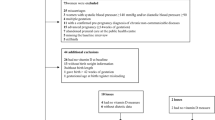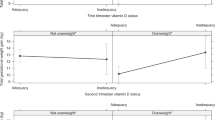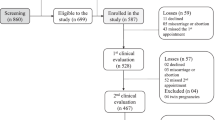Abstract
Objective:
We aimed to study whether prenatal vitamin (PNV) use protects against low 25-hydroxyvitamin D (25[OH]D) levels in all women and particularly in obese and black women who are both at risk of vitamin D deficiency and poor pregnancy outcomes.
Study design:
We studied 1019 women enrolled in a prospective study at Brigham and Women’s Hospital in Boston, from 2007 to 2009. We used multivariable logistic regression to analyze associations of PNV use and odds of vitamin D deficiency defined as 25[OH]D levels <50 nmol l−1.
Result:
In all, 56% of black and 86% of white women reported pre- and/or postconceptional PNV use. In the first trimester, 75% of black and 19% of white women were vitamin D deficient. Lack of PNV use among black women was not associated with vitamin D deficiency (adjusted odds ratio (OR) 1.0, 95% confidence interval (CI) 0.4, 2.3) but was among white women (OR 3.5, 95% CI 2.1, 5.8) (interaction P<0.01).
Conclusions:
Ongoing trials of vitamin D supplementation during pregnancy should consider potential effect modification by race/ethnicity.
This is a preview of subscription content, access via your institution
Access options
Subscribe to this journal
Receive 12 print issues and online access
$259.00 per year
only $21.58 per issue
Buy this article
- Purchase on Springer Link
- Instant access to full article PDF
Prices may be subject to local taxes which are calculated during checkout

Similar content being viewed by others
References
MacDorman MF . Race and ethnic disparities in fetal mortality, preterm birth, and infant mortality in the United States: an overview. Semin Perinatol 2011; 35 (4): 200–208.
Eskenazi B, Fenster L, Sidney S . A multivariate analysis of risk factors for preeclampsia. JAMA 1991; 266 (2): 237–241.
Timofeev J, Feghali M, Boyle A, Istwan N, Rhea D, Driggers RW . Rates of recurrent preterm birth by maternal body habitus in women receiving 17alpha-hydroxyprogesterone caproate. J Matern Fetal Neonatal Med 2013; 26 (9): 881–884.
Holick MF . Photosynthesis of vitamin D in the skin: effect of environmental and life-style variables. Fed Proc 1987; 46 (5): 1876–1882.
Holick MF . Vitamin D deficiency. N Engl J Med 2007; 357 (3): 266–281.
Kim SY, Saraiva C, Curtis M, Wilson HG, Troyan J, England L et al. Fraction of gestational diabetes mellitus attributable to overweight and obesity by race/ethnicity, California, 2007-2009. Am J Public Health 2013; 103 (10): e65–e72.
Bodnar LM, Catov JM, Roberts JM, Simhan HN . Prepregnancy obesity predicts poor vitamin D status in mothers and their neonates. J Nutr 2007; 137 (11): 2437–2442.
Honein MA, Devine O, Sharma AJ, Rasmussen SA, Park S, Kucik JE et al. Modeling the potential public health impact of prepregnancy obesity on adverse fetal and infant outcomes. Obesity 2013; 21 (6): 1276–1283.
Burris HH, Rifas-Shiman SL, Kleinman K, Litonjua AA, Huh SY, Rich-Edwards JW et al. Vitamin D deficiency in pregnancy and gestational diabetes mellitus. Am J Obstet Gynecol 2012; 207 (3): 182.e1–8.
Zhang C, Qiu C, Hu FB, David RM, van Dam RM, Bralley A et al. Maternal plasma 25-hydroxyvitamin D concentrations and the risk for gestational diabetes mellitus. PLoS One 2008; 3 (11): e3753.
Bodnar LM, Catov JM, Simhan HN, Holick MF, Powers RW, Roberts JM . Maternal vitamin D deficiency increases the risk of preeclampsia. J Clin Endocrinol Metab 2007; 92 (9): 3517–3522.
Bodnar LM, Klebanoff MA, Gernand AD, Platt RW, Parks WT, Catov JM et al. Maternal vitamin D status and spontaneous preterm birth by placental histology in the us collaborative perinatal project. Am J Epidemiol 2014; 179 (2): 168–176.
Burris HH, Rifas-Shiman SL, Camargo CA Jr., Litonjua AA, Huh SY, Rich-Edwards JW et al. Plasma 25-hydroxyvitamin D during pregnancy and small-for-gestational age in black and white infants. Ann Epidemiol 2012; 22 (8): 581–586.
Bodnar LM, Catov JM, Zmuda JM, Cooper ME, Parrott MS, Roberts JM et al. Maternal serum 25-hydroxyvitamin D concentrations are associated with small-for-gestational age births in white women. J Nutr 2010; 140 (5): 999–1006.
Wei SQ, Qi HP, Luo ZC, Fraser WD . Maternal vitamin D status and adverse pregnancy outcomes: a systematic review and meta-analysis. J Matern Fetal Neonatal Med 2013; 26 (9): 889–899.
Aghajafari F, Nagulesapillai T, Ronksley PE, Tough SC, O'Beirne M, Rabi DM . Association between maternal serum 25-hydroxyvitamin D level and pregnancy and neonatal outcomes: systematic review and meta-analysis of observational studies. BMJ 2013; 346: f1169.
Gernand AD, Simhan HN, Caritis S, Bodnar LM . Maternal vitamin D status and small-for-gestational-age offspring in women at high risk for preeclampsia. Obstet Gynecol 2014; 123 (1): 40–48.
Bodnar LM, Simhan HN . Vitamin D may be a link to black-white disparities in adverse birth outcomes. Obstet Gynecol Surv 2010; 65 (4): 273–284.
Burris HH, Mitchell AA, Werler MM . Periconceptional multivitamin use and infant birth weight disparities. Ann Epidemiol 2010; 20 (3): 233–240.
McElrath TF, Lim KH, Pare E, Rich-Edwards J, Pucci D, Troisi R et al. Longitudinal evaluation of predictive value for preeclampsia of circulating angiogenic factors through pregnancy. Am J Obstet Gynecol 2012; 207 (5): 407 e401–407.
Ersfeld DL, Rao DS, Body JJ, Sackrison JL Jr., Miller AB, Parikh N et al. Analytical and clinical validation of the 25 OH vitamin D assay for the LIAISON automated analyzer. Clin Biochem 2004; 37 (10): 867–874.
Bischoff-Ferrari HA, Giovannucci E, Willett WC, Dietrich T, Dawson-Hughes B . Estimation of optimal serum concentrations of 25-hydroxyvitamin D for multiple health outcomes. Am J Clin Nutr 2006; 84 (1): 18–28.
Holmes VA, Barnes MS, Alexander HD, McFaul P, Wallace JM . Vitamin D deficiency and insufficiency in pregnant women: a longitudinal study. Br J Nutr 2009; 102 (6): 876–881.
Ginde AA, Sullivan AF, Mansbach JM, Camargo CA Jr . Vitamin D insufficiency in pregnant and nonpregnant women of childbearing age in the United States. Am J Obstet Gynecol 2010; 202 (5): 436 e431–438.
Burris HH, Rifas-Shiman SL, Kleinman K, Litonjua AA, Huh SY, Rich-Edwards JW et al. Vitamin D deficiency in pregnancy and gestational diabetes mellitus. Am J Obstet Gynecol 2012; 207 (3): 182 e181–188.
Shea MK, Houston DK, Tooze JA, Davis CC, Johnson MA, Hausman DB et al. Correlates and prevalence of insufficient 25-hydroxyvitamin D status in black and white older adults: the health, aging and body composition study. J Am Geriatr Soc 2011; 59 (7): 1165–1174.
Ustuner I, Keskin HL, Tas EE, Neselioglu S, Sengul O, Avsar AF . Maternal serum 25(OH)D levels in the third trimester of pregnancy during the winter season. J Matern Fetal Neonatal Med 2011; 24 (12): 1421–1426.
Acknowledgements
Dr Burris received support from NIH/NIEHS K23ES022242 and Klarman Scholars Program at Beth Israel Deaconess Medical Center. Dr McElrath received funds from an unrestricted grant from Abbott Diagnostics. This work was also supported through the generosity of the Zugg family.
Author information
Authors and Affiliations
Corresponding author
Ethics declarations
Competing interests
The authors declare no conflict of interest.
Rights and permissions
About this article
Cite this article
Burris, H., Thomas, A., Zera, C. et al. Prenatal vitamin use and vitamin D status during pregnancy, differences by race and overweight status. J Perinatol 35, 241–245 (2015). https://doi.org/10.1038/jp.2014.198
Received:
Revised:
Accepted:
Published:
Issue Date:
DOI: https://doi.org/10.1038/jp.2014.198
This article is cited by
-
Racial disparities in cord blood vitamin D levels and its association with small-for-gestational-age infants
Journal of Perinatology (2016)



